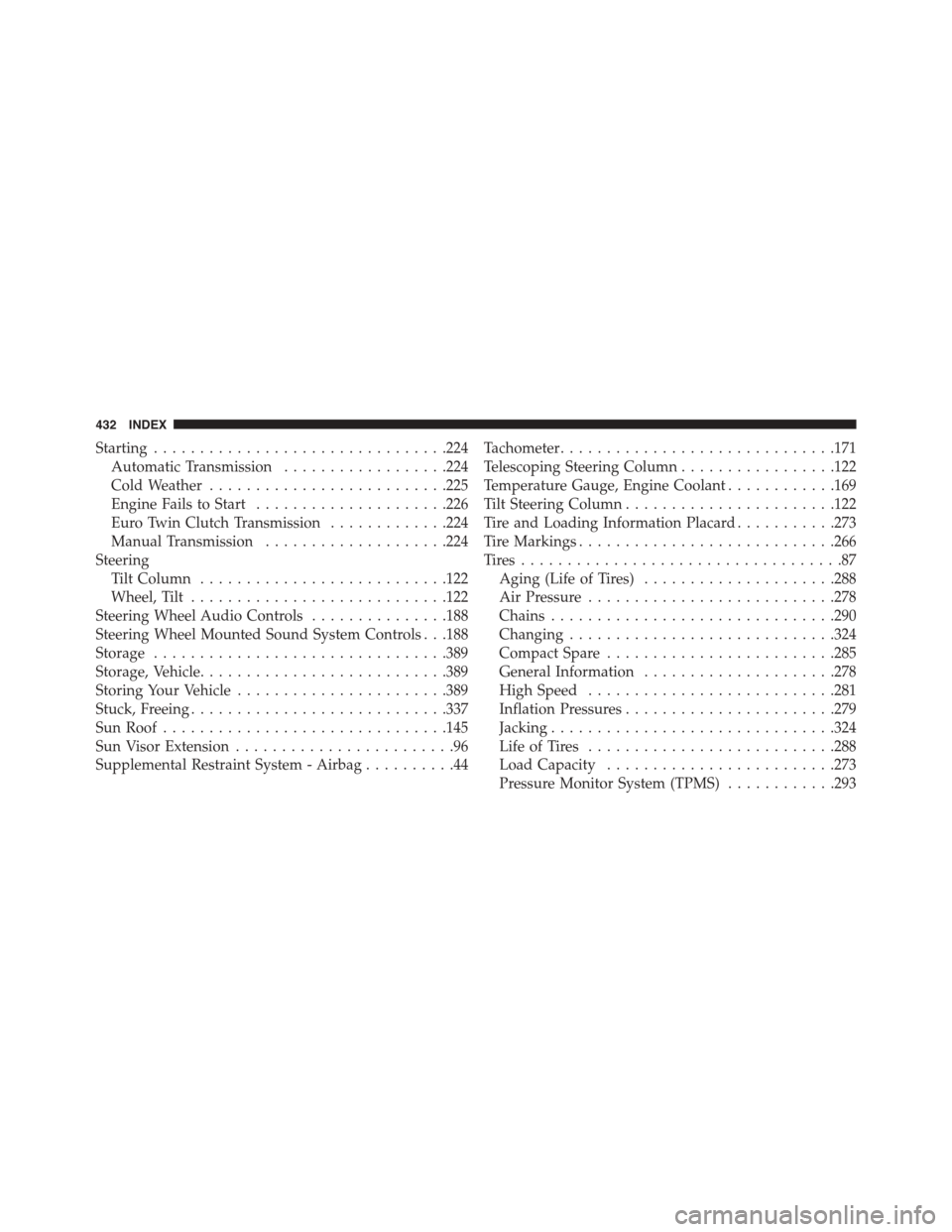Page 370 of 438

•Use only high purity water such as distilled or deion-
ized water when mixing the water/engine coolant
(antifreeze) solution. The use of lower quality water
will reduce the amount of corrosion protection in the
engine cooling system.
Please note that it is the owner’s responsibility to main-
tain the proper level of protection against freezing ac-
cording to the temperatures occurring in the area where
the vehicle is operated.
NOTE:
•Some vehicles require special tools to add coolant
properly. Failure to fill these systems properly could
lead to severe internal engine damage. If any coolant is
needed to be added to the system please contact your
local authorized dealer.
•Mixing engine coolant (antifreeze) types is not recom-
mended and can result in cooling system damage. If
HOAT and OAT coolant are mixed in an emergency,
have a authorized dealer drain, flush, and refill with
OAT coolant (conforming to MS.90032) as soon as
possible.
Cooling System Pressure Cap
The cap must be fully tightened to prevent loss of engine
coolant (antifreeze) and to ensure that engine coolant
(antifreeze) will return to the radiator from the coolant
recovery tank.
The cap should be inspected and cleaned if there is any
accumulation of foreign material on the sealing surfaces.
368 MAINTAINING YOUR VEHICLE
Page 371 of 438

WARNING!
•Do not open hot engine cooling system. Never add
engine coolant (antifreeze) when the engine is
overheated. Do not loosen or remove the cap to cool
an overheated engine. Heat causes pressure to
build up in the cooling system. To prevent scalding
or injury, do not remove the pressure cap while the
system is hot or under pressure.
•Do not use a pressure cap other than the one
specified for your vehicle. Personal injury or en-
gine damage may result.
Disposal Of Used Engine Coolant
Used ethylene glycol-based engine coolant (antifreeze) is
a regulated substance requiring proper disposal. Check
with your local authorities to determine the disposal
rules for your community. To prevent ingestion by ani-
mals or children, do not store ethylene glycol-based
engine coolant in open containers or allow it to remain in
puddles on the ground. If ingested by a child or pet, seek
emergency assistance immediately. Clean up any ground
spills immediately.
Coolant Level
The coolant expansion bottle provides a quick visual
method for determining that the coolant level is ad-
equate. With the engine off and cold, the level of the
engine coolant (antifreeze) in the bottle should be be-
tween the “MIN” and “MAX” marks.
As long as the engine operating temperature is satisfac-
tory, the coolant bottle need only be checked once a
month.
When additional engine coolant (antifreeze) is needed to
maintain the proper level, it should be added to the
coolant bottle. Do not overfill.
7
MAINTAINING YOUR VEHICLE 369
Page 428 of 438

Gasoline, Reformulated.....................299
Gauges
Coolant Temperature.....................169
Fuel.................................169
Odometer.............................175
Tachometer............................171
Gear Ranges.............................233
Gear Select Lever Override..................339
General Information.......................298
General Maintenance.......................175
Glass Cleaning...........................382
Hazard
Driving Through Flowing, Rising, or Shallow
Standing Water.........................252
Headlights..............................113
Cleaning.............................382
High Beam............................171
Passing..............................114
Heated Mirrors............................96
Hill Start Assist...........................260
Holder, Cup.............................150
HomeLink® (Garage Door Opener)............136
Hood Release............................110
Ignition
Key . . . . . . . . . . . . . . . . . . . . . . . . . . . . . . . . . .11
Immobilizer (Sentry Key)....................14
Information Center, Vehicle..................177
Inside Rearview Mirror......................92
Instrument Cluster........................167
Instrument Panel and Controls................165
Instrument Panel Cover.....................382
Instrument Panel Lens Cleaning...............383
Interior Appearance Care....................381
Interior Lighting..........................115
Introduction..............................4
426 INDEX
Page 434 of 438

Starting................................224
Automatic Transmission..................224
Cold Weather..........................225
Engine Fails to Start.....................226
Euro Twin Clutch Transmission.............224
Manual Transmission....................224
Steering
Tilt Column...........................122
Wheel, Tilt............................122
Steering Wheel Audio Controls...............188
Steering Wheel Mounted Sound System Controls . . .188
Storage................................389
Storage, Vehicle...........................389
Storing Your Vehicle.......................389
Stuck, Freeing............................337
Sun Roof...............................145
Sun Visor Extension........................96
Supplemental Restraint System - Airbag..........44
Tachometer..............................171
Telescoping Steering Column.................122
Temperature Gauge, Engine Coolant............169
Tilt Steering Column.......................122
Tire and Loading Information Placard...........273
Tire Markings............................266
Ti re s . . . . . . . . . . . . . . . . . . . . . . . . . . . . . . . . . . . 8 7
Aging (Life of Tires).....................288
Air Pressure...........................278
Chains...............................290
Changing.............................324
Compact Spare.........................285
General Information.....................278
High Speed...........................281
Inflation Pressures.......................279
Jacking...............................324
Life of Tires...........................288
Load Capacity.........................273
Pressure Monitor System (TPMS)............293
432 INDEX